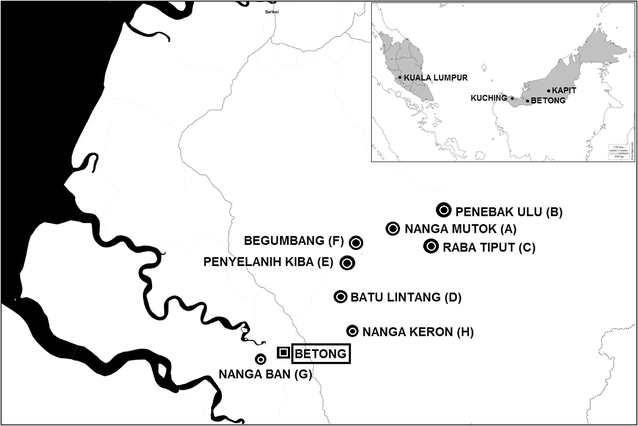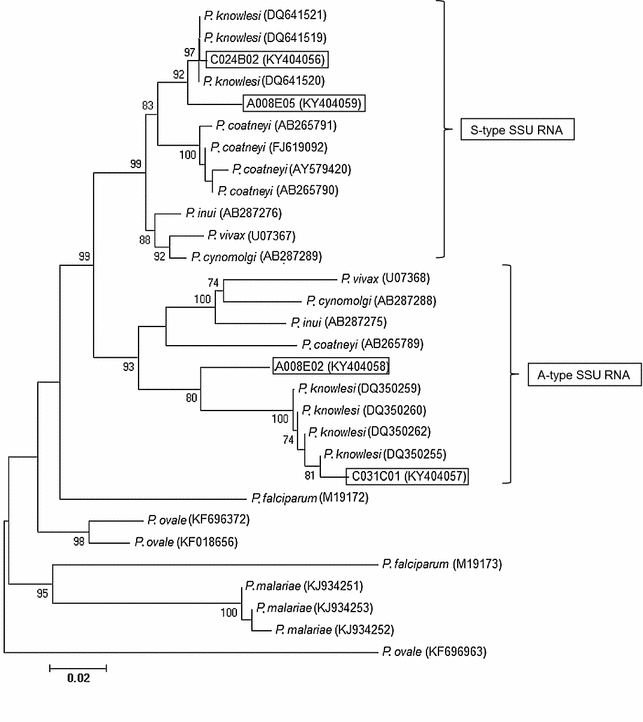Absence of Plasmodium inui and Plasmodium cynomolgi, but detection of Plasmodium knowlesi and Plasmodium vivax infections in asymptomatic humans in the Betong division of Sarawak, Malaysian Borneo
- PMID: 29041929
- PMCID: PMC5645983
- DOI: 10.1186/s12936-017-2064-9
Absence of Plasmodium inui and Plasmodium cynomolgi, but detection of Plasmodium knowlesi and Plasmodium vivax infections in asymptomatic humans in the Betong division of Sarawak, Malaysian Borneo
Erratum in
-
Correction to: Absence of Plasmodium inui and Plasmodium cynomolgi, but detection of Plasmodium knowlesi and Plasmodium vivax infections in asymptomatic humans in the Betong division of Sarawak, Malaysian Borneo.Malar J. 2017 Nov 6;16(1):445. doi: 10.1186/s12936-017-2093-4. Malar J. 2017. PMID: 29110664 Free PMC article.
Abstract
Background: Plasmodium knowlesi, a simian malaria parasite, has become the main cause of malaria in Sarawak, Malaysian Borneo. Epidemiological data on malaria for Sarawak has been derived solely from hospitalized patients, and more accurate epidemiological data on malaria is necessary. Therefore, a longitudinal study of communities affected by knowlesi malaria was undertaken.
Methods: A total of 3002 blood samples on filter paper were collected from 555 inhabitants of 8 longhouses with recently reported knowlesi malaria cases in the Betong Division of Sarawak, Malaysian Borneo. Each longhouse was visited bimonthly for a total of 10 times during a 21-month study period (Jan 2014-Oct 2015). DNA extracted from blood spots were examined by a nested PCR assay for Plasmodium and positive samples were then examined by nested PCR assays for Plasmodium falciparum, Plasmodium vivax, Plasmodium malariae, Plasmodium ovale, Plasmodium knowlesi, Plasmodium cynomolgi and Plasmodium inui. Blood films of samples positive by PCR were also examined by microscopy.
Results: Genus-specific PCR assay detected Plasmodium DNA in 9 out of 3002 samples. Species-specific PCR identified 7 P. knowlesi and one P. vivax. Malaria parasites were observed in 5 thick blood films of the PCR positive samples. No parasites were observed in blood films from one knowlesi-, one vivax- and the genus-positive samples. Only one of 7 P. knowlesi-infected individual was febrile and had sought medical treatment at Betong Hospital the day after sampling. The 6 knowlesi-, one vivax- and one Plasmodium-infected individuals were afebrile and did not seek any medical treatment.
Conclusions: Asymptomatic human P. knowlesi and P. vivax malaria infections, but not P. cynomolgi and P. inui infections, are occurring within communities affected with malaria.
Keywords: Asymptomatic; Malaria; Plasmodium knowlesi; Submicroscopic.
Figures




Similar articles
-
Evidence of asymptomatic submicroscopic malaria in low transmission areas in Belaga district, Kapit division, Sarawak, Malaysia.Malar J. 2019 May 2;18(1):156. doi: 10.1186/s12936-019-2786-y. Malar J. 2019. PMID: 31046769 Free PMC article.
-
Improved limit of detection for zoonotic Plasmodium knowlesi and P. cynomolgi surveillance using reverse transcription for total nucleic acid preserved samples or dried blood spots.PLoS Negl Trop Dis. 2025 Feb 6;19(2):e0012129. doi: 10.1371/journal.pntd.0012129. eCollection 2025 Feb. PLoS Negl Trop Dis. 2025. PMID: 39913530 Free PMC article.
-
Asymptomatic Natural Human Infections With the Simian Malaria Parasites Plasmodium cynomolgi and Plasmodium knowlesi.J Infect Dis. 2019 Feb 15;219(5):695-702. doi: 10.1093/infdis/jiy519. J Infect Dis. 2019. PMID: 30295822 Free PMC article.
-
The emerging of the fifth malaria parasite (Plasmodium knowlesi): a public health concern?Braz J Infect Dis. 2010 May-Jun;14(3):299-309. Braz J Infect Dis. 2010. PMID: 20835518 Review.
-
Plasmodium knowlesi: from Malaysia, a novel health care threat.Infez Med. 2012 Mar;20(1):5-11. Infez Med. 2012. PMID: 22475654 Review.
Cited by
-
Natural Plasmodium inui Infections in Humans and Anopheles cracens Mosquito, Malaysia.Emerg Infect Dis. 2021 Oct;27(10):2700-2703. doi: 10.3201/eid2710.210412. Emerg Infect Dis. 2021. PMID: 34545786 Free PMC article.
-
Prevalence of Asymptomatic and/or Low-Density Malaria Infection among High-Risk Groups in Peninsular Malaysia.Am J Trop Med Hyg. 2020 Sep;103(3):1107-1110. doi: 10.4269/ajtmh.20-0268. Am J Trop Med Hyg. 2020. PMID: 32618263 Free PMC article.
-
Malaria Cases in a Tertiary Hospital in Kuala Lumpur, Malaysia: A 16-Year (2005-2020) Retrospective Review.Trop Med Infect Dis. 2021 Sep 29;6(4):177. doi: 10.3390/tropicalmed6040177. Trop Med Infect Dis. 2021. PMID: 34698312 Free PMC article.
-
Natural Human Infections with Plasmodium cynomolgi, P. inui, and 4 other Simian Malaria Parasites, Malaysia.Emerg Infect Dis. 2021 Aug;27(8):2187-2191. doi: 10.3201/eid2708.204502. Emerg Infect Dis. 2021. PMID: 34287122 Free PMC article.
-
Plasmodium cynomolgi Infections Not Found in Microscopy-Diagnosed Malaria Cases across Sabah, Malaysia.Am J Trop Med Hyg. 2024 Nov 12;112(1):85-88. doi: 10.4269/ajtmh.24-0264. Print 2025 Jan 8. Am J Trop Med Hyg. 2024. PMID: 39531730 Free PMC article.
References
-
- Sinton JA, Mulligan HW. Plasmodium knowlesi. In: The primate malarias. Bethesda: U.S. National Institute of Allergy and Infectious Diseases [for sale by the Supt. of Docs., U.S. Govt Print Off., Washington]. 1971. p. 317.
Publication types
MeSH terms
LinkOut - more resources
Full Text Sources
Other Literature Sources
Medical
Molecular Biology Databases

